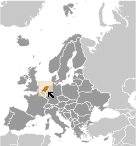World Atlas: Netherlands. On this page you can see the map, country flag and many detailed information about the people, history and economy of Netherlands.

Here you can find online selected information about the geography, inhabitants, government, economy and history of Netherlands. Included are selected statistics, an overview map and the detailed map of Netherlands. But let's start with the flag of Netherlands here:
Netherlands - Overview:
What you should know about Netherlands? Let's start with this: The Dutch United Provinces declared their independence from Spain in 1579; during the 17th century, they became a leading seafaring and commercial power, with settlements and colonies around the world. After a 20-year French occupation, a Kingdom of the Netherlands was formed in 1815. In 1830, Belgium seceded and formed a separate kingdom. The Netherlands remained neutral in World War I, but suffered German invasion and occupation in World War II. A modern, industrialized nation, the Netherlands is also a large exporter of agricultural products. The country was a founding member of NATO and the EEC (now the EU) and participated in the introduction of the euro in 1999. In October 2010, the former Netherlands Antilles was dissolved and the three smallest islands - Bonaire, Sint Eustatius, and Saba - became special municipalities in the Netherlands administrative structure. The larger islands of Sint Maarten and Curacao joined the Netherlands and Aruba as constituent countries forming the Kingdom of the Netherlands.
Geography of Netherlands
 Where on the globe is Netherlands? The location of this country is Western Europe, bordering the North Sea, between Belgium and Germany. Total area of Netherlands is 41,543 sq km, of which 33,893 sq km is land. So this is not a large country. How could we describe the terrain of the country? This way: mostly coastal lowland and reclaimed land (polders); some hills in southeast. The lowest point of Netherlands is Zuidplaspolder -7 m, the highest point Mount Scenery 862 m (on the island of Saba in the Caribbean, now considered an integral part of the Netherlands following the dissolution of the Netherlands Antilles). And the climate is temperate; marine; cool summers and mild winters.
Where on the globe is Netherlands? The location of this country is Western Europe, bordering the North Sea, between Belgium and Germany. Total area of Netherlands is 41,543 sq km, of which 33,893 sq km is land. So this is not a large country. How could we describe the terrain of the country? This way: mostly coastal lowland and reclaimed land (polders); some hills in southeast. The lowest point of Netherlands is Zuidplaspolder -7 m, the highest point Mount Scenery 862 m (on the island of Saba in the Caribbean, now considered an integral part of the Netherlands following the dissolution of the Netherlands Antilles). And the climate is temperate; marine; cool summers and mild winters.
Inhabitants of Netherlands
Let's take a look how many people live in Netherlands. The number is: 17,084,719 (July 2017 est.). So this is not very populous country. Who lives here? Dutch 77.4%, EU 6.2%, Turkish 2.3%, Moroccan 2.3%, Indonesian 2.1%, Surinamese 2%, other 7.7% (2017 est.). What are the languages in Netherlands? Dutch (official). And the religions: Roman Catholic 23.7%, Protestant 15.5% (includes Dutch Reformed 6.5%, Protestant Church of The Netherlands 5.7%, Calvinist 3.3%), Islam 4.9%, other 5.7% (includes Hindu, Buddhist, Jewish), none 50.1% (2015 est.). How old are the people in average? 42.6 years. We have to add that this number is the median - so one half of the people is older than this, one half is younger. And what is their life expectancy (at birth)? This: 81.4 years. Where the people live in Netherlands? Here: an area known as the Randstad, anchored by the cities of Amsterdam, Rotterdam, the Hague, and Utrecht, is the most densely populated region; the north tends to be less dense, though sizeable communities can be found throughout the entire country. The major urban areas of Netherlands are: Amsterdam (capital) 1.091 million; Rotterdam 993,000; The Hague (seat of government) 650,000 (2015).
Government and Economy of Netherlands
The capital of Netherlands is Amsterdam; note - The Hague is the seat of government and the government type parliamentary constitutional monarchy; part of the Kingdom of the Netherlands. Let's take a look at the administrative divisions - 12 provinces (provincies, singular - provincie); Drenthe, Flevoland, Fryslan (Friesland), Gelderland, Groningen, Limburg, Noord-Brabant (North Brabant), Noord-Holland (North Holland), Overijssel, Utrecht, Zeeland (Zealand), Zuid-Holland (South Holland). Regarding the economy of Netherlands, important industrial products are agroindustries, metal and engineering products, electrical machinery and equipment, chemicals, petroleum, construction, microelectronics, fishing. Important agricultural products are vegetables, ornamentals, dairy, poultry and livestock products; propagation materials. The most important export commodities are machinery and transport equipment, chemicals, mineral fuels; food and livestock, manufactured goods and the most important export partners are Germany 24.1%, Belgium 10.7%, UK 9.4%, France 8.8%, Italy 4.2% (2016). The most important import commodities are machinery and transport equipment, chemicals, fuels, foodstuffs, clothing and the most important import partners are Germany 15.3%, China 14.1%, Belgium 8.4%, US 7.9%, UK 5.3%, Russia 4.1% (2016). How rich is Netherlands and how rich are people in this country? The most important number here is GDP per capita (PPP): $53,600 (2017 est.). This means the people are rich on average here. Let's add that this means Gross Domestic Product per person, which is recalculated with respect to the relative cost of local goods and services. And one more important number - population below poverty line: 8.8% (2015 est.).